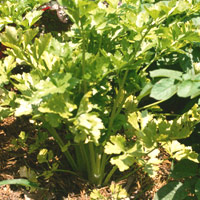Celery

Celery has a reputation for being a fussy, hard-to-grow vegetable, but with the right climate and some care, you can grow large, tender plants.
About This Plant
Celery requires about 125 days of a long, relatively cool growing season. For a summer harvest, start plants indoors ten to twelve weeks before the last spring frost date. Where the fall climate is mild, try a midsummer seeding in the garden. Some gardeners prefer to blanch celery for a milder taste when eaten raw. If you're pressed for time, try a self-blanching variety.
Site Selection
Select a site with full sun and well-drained soil. Prepare the garden bed by using a garden fork or tiller to loosen the soil to a depth of 12 to 15 inches, then mix in a 2- to 4-inch layer of compost.
Planting Instructions
Presoak seeds to speed germination, whether you're starting them indoors or sowing directly in the garden. If starting indoors, sow seeds indoors in small pots or flats. Move to individual containers when they are 2 inches tall. Set out transplants 8 to 10 inches apart in rows 10 inches apart a week or so before your last spring frost date. In areas with a long growing season, sow seeds in the garden at a depth of 1/8 inch in rows 30 to 36 inches apart after soil temperature reaches 60 degrees F.
Care
Thin direct-seeded celery plants to stand 8 to 10 inches apart when they're 4 to 5 inches tall. Apply a heavy layer of mulch immediately after planting and provide a regular supply of water. Celery is a heavy feeder, so you may want to fertilize plants with compost tea or side-dress plants with rich compost several times during the growing season. Blanch varieties that require it when the plants are 12 inches tall. Contact your local county extension office for controls of common celery pests, such as earwigs.
Harvest
Start harvesting outer stalks when they are 6 to 8 inches tall. Harvest stalks in fall as needed before the ground freezes. Celery can tolerate light frosts.






 Celery has a reputation for being a fussy, hard-to-grow vegetable, but with the right climate and some care, you can grow large, tender plants.
Celery has a reputation for being a fussy, hard-to-grow vegetable, but with the right climate and some care, you can grow large, tender plants.